Papers by Ertimiss Eshkevari

Journal of Behavior Therapy and Experimental Psychiatry, 2016
Self-focused attention is hypothesized to be a maintenance factor in body dysmorphic disorder (BD... more Self-focused attention is hypothesized to be a maintenance factor in body dysmorphic disorder (BDD). The aim of this study was to use an experimental paradigm to test this hypothesis by studying the effect of self-focused attention during mirror-gazing on appearance dissatisfaction. An experimental group design was used, in which 173 women were randomly allocated to one of three conditions before mirror-gazing for 2 min: (a) external focus of attention, (b) self-focus of attention, and (c) self-focus of attention with a negative mood induction. After mirror-gazing, participants across all groups rated themselves as being more dissatisfied with their appearance. In both the self-focus conditions, there was an increase in sadness from pre to post mirror gazing, and there was a significant difference in focus of attention for participants in the self-focused, mood-induced group from pre to post manipulation, suggesting mood induction had more of an effect than focus of attention. (1) there was no condition involving an external focus with a negative mood induction, and (2) due to the level of information provided to patients on the nature of the task, we cannot rule out demand characteristics as an influencing factor on our results. Self-focused attention during mirror-gazing may act indirectly to increase appearance dissatisfaction via the effect of negative mood. Further studies are required to establish the relative contribution of self-focused attention and negative mood to increases in appearance dissatisfaction as a function of mirror-gazing.

Neuroscience & Biobehavioral Reviews, 2014
Social and emotional problems have been implicated in the development and maintenance of eating d... more Social and emotional problems have been implicated in the development and maintenance of eating disorders (ED). This paper reviews the facets of social processing in ED according to the NIMH Research and Domain Criteria (NIMH RDoC) 'Systems for Social Processes' framework. Embase, Medline, PsycInfo and Web of Science were searched for peer-reviewed articles published by March 2013. One-hundred and fifty four studies measuring constructs of: attachment, social communication, perception and understanding of self and others, and social dominance in people with ED, were identified. Eleven meta-analyses were performed, they showed evidence that people with ED had attachment insecurity (d=1.31), perceived low parental care (d=.51), appraised high parental overprotection (d=0.29), impaired facial emotion recognition (d=.44) and facial communication (d=2.10), increased facial avoidance (d=.52), reduced agency (d=.39), negative self-evaluation (d=2.27), alexithymia (d=.66), poor understanding of mental states (d=1.07) and sensitivity to social dominance (d=1.08). There is less evidence for problems with production and reception of non-facial communication, animacy and action.
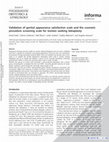
Journal of Psychosomatic Obstetrics & Gynecology, 2013
Background: Existing outcome studies on women seeking labiaplasty have not used a validated scale... more Background: Existing outcome studies on women seeking labiaplasty have not used a validated scale that is specific for satisfaction with genital appearance. They have also not screened for the presence of body dysmorphic disorder (BDD). There are therefore two primary aims of this study (1) to validate the Genital Appearance Satisfaction (GAS) scale in women seeking labiaplasty and (2) to modify and validate a version of the Cosmetic Procedures Screening questionnaire (COPS-L), which has previously been used to screen for BDD. Method: Two groups of women were recruited: a group desiring labiaplasty and a control group. All participants completed the GAS, the COPS-L and other general measures of mood, disgust sensitivity, sexual satisfaction and body image quality of life. Results: Both the GAS and COPS-L demonstrated good internal consistency, concurrent and convergent validity with measures of related constructs, and discriminated between women seeking labiaplasty and controls. Three factors were identified in the GAS but were not robust enough to recommend their use clinically as subscales. The COPS-L discriminated between women seeking labiaplasty with and without BDD. Discussion: We recommend that both the GAS and the COPS-L be routinely used for audit and outcome monitoring of interventions for women distressed by the appearance or function of their genitalia. The GAS has an advantage in assessing additional functional symptoms in such women. The COPS-L may be helpful in identifying women with BDD. J Psychosom Obstet Gynaecol Downloaded from informahealthcare.com by Ms Sarah Fay on 02/26/13 For personal use only. 48 D. Veale et al. J Psychosom Obstet Gynaecol, 2013; 34(1): 46-52 J Psychosom Obstet Gynaecol Downloaded from informahealthcare.com by Ms Sarah Fay on 02/26/13 For personal use only. Items in bold refer to the factors extracted which are 40.4. 50 D. Veale et al. Validation of genital appearance satisfaction scale and the cosmetic procedure 51 J Psychosom Obstet Gynaecol Downloaded from informahealthcare.com by Ms Sarah Fay on 02/26/13

Behaviour Research and Therapy, 2015
Depression in adolescents is a common and impairing problem. Effective psychological therapies fo... more Depression in adolescents is a common and impairing problem. Effective psychological therapies for depression are not accessed by most adolescents. Computerised therapy offers huge potential for improving access to treatment. To test the efficacy of Stressbusters, a Computerised-CBT (C-CBT) programme for depression in young people. Multi-site, schools-based, RCT of C-CBT compared to Waiting List, for young people (N = 112; aged 12-16) with significant symptoms of depression, using multiple-informants (adolescents, parents, teachers), with follow-up at 3 and 6 months. Relative to being on a Waiting List, C-CBT was associated with statistically significant and clinically meaningful improvements in symptoms of depression and anxiety according to adolescent self-report; and with a trend towards improvements in depression and anxiety according to parent-report. Improvements were maintained at follow-up. Treatment gains were similar for boys and girls across the participating age range. Treatment effect was partially mediated by changes in ruminative thinking. Teachers rated adolescents as having few emotional or behavioural problems, both before and after intervention. C-CBT had no detectable effect on academic attainment. In the month after intervention, young people who received C-CBT had significantly fewer absences from school than those on the Waiting List. C-CBT shows considerable promise for the treatment of mild-moderate depression in adolescents.
A diagram is provided to show the anatomy of the female genitalia.
This questionnaire is about the way you feel about the appearance of your genitalia. The outer li... more This questionnaire is about the way you feel about the appearance of your genitalia. The outer lips of your gentialia are called the "labia" Please answer how you feel for over the past week.
Below are a number of beliefs that you might have because of the size or appearance of your penis... more Below are a number of beliefs that you might have because of the size or appearance of your penis. Please rate how strongly you agree or disagree with each of the following statements using the scale below:

European eating disorders review : the journal of the Eating Disorders Association, 2014
Interoception has been proposed to play an important role in the pathogenesis of eating disorders... more Interoception has been proposed to play an important role in the pathogenesis of eating disorders (EDs). The aim of this study was to examine a heart beat detection task (HBDT) as an objective index of interoceptive sensitivity in individuals with an ED. The self-report interoceptive deficits subscale of the Eating Disorders Inventory 3 was also used. The results of the HBDT demonstrated no significant difference between individuals with an ED and healthy controls. However, performance on this task also did not appear to be different from that expected by chance. Thus, these results cast doubt on the utility of the present HBDT for measuring interoceptive sensitivity. Overall, the findings indicate that further research is needed to develop valid, objective measures of interoceptive sensitivity to be used in EDs, so as to overcome the reliance on the Eating Disorders Inventory 3 self-report subscale and to determine how such measures relate to ED and general psychopathology.
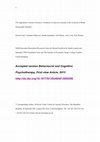
Behavioural and cognitive psychotherapy, 2013
Background: At present there are no measures to identify the cognitive processes and behaviours t... more Background: At present there are no measures to identify the cognitive processes and behaviours that might mediate the outcome of treatment in people with Body Dysmorphic Disorder (BDD). Aims: To develop and validate a process measure that can be used to assess the progress of patients throughout therapy and in research for BDD. Method: The psychometric properties of the Appearance Anxiety Inventory (AAI) were explored in a clinical group of participants diagnosed with BDD (Study 1) and in a non-clinical community group with high appearance concerns (Study 2). Item characteristics, reliability, and factor structure were analysed. Convergent validity with measures of related symptoms was assessed. Results: The AAI was found to have good test-retest reliability and convergent validity in the measurement of appearance anxiety. It was also sensitive to change during treatment. The scale was found to have a two-factor structure in the clinical group, with one factor characterized by avoidance, and a second factor comprised of threat monitoring. However, in the community sample it appeared to have a one-factor structure. Conclusion: The results suggest that the AAI has the psychometric properties to determine whether changes in cognitive processes and behaviours can mediate the outcome following treatment in patients with BDD. This supports its potential usefulness in clinical and research settings.
Body image, 2014
• Women seeking labiaplasty were compared to a comparison group

Psychological medicine, 2014
Background Labiaplasty is an increasingly popular surgical intervention but little is known about... more Background Labiaplasty is an increasingly popular surgical intervention but little is known about the characteristics and motivation of women who seek the procedure or the psychosexual outcome.Method A total of 55 women seeking labiaplasty were compared with 70 women who did not desire labiaplasty. Various general measures of psychopathology as well as specific measures (Genital Appearance Satisfaction; Cosmetic Procedure Screening for labiaplasty) were used. Labia measurements of the women seeking labiaplasty were also obtained.Results Women seeking labiaplasty did not differ from controls on measures of depression or anxiety. They did, however, express increased dissatisfaction towards the appearance of their genitalia, with lower overall sexual satisfaction and a poorer quality of life in terms of body image. Women seeking labiaplasty reported a significantly greater frequency of avoidance behaviours on all the domains assessed, and greater frequency of safety-seeking behaviours for most of the domains. Key motivations reported for labiaplasty were categorized as cosmetic, functional or sexual. Of the 55 women seeking labiaplasty, 10 met diagnostic criteria for body dysmorphic disorder.Conclusions This is the first controlled study to describe some of the characteristics and motivations of women seeking labiaplasty. We identified a wide range of avoidance and safety-seeking behaviours, which occurred more frequently in the labiaplasty group than the control group. These could be used clinically as part of a psychological intervention for women seeking labiaplasty.(Received December 18 2012)(Revised April 01 2013)(Accepted April 11 2013)(Online publication May 10 2013)
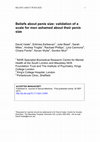
The journal of sexual medicine, 2014
IntroductionNo measures are available for understanding beliefs in men who experience shame about... more IntroductionNo measures are available for understanding beliefs in men who experience shame about the perceived size of their penis. Such a measure might be helpful for treatment planning, and measuring outcome after any psychological or physical intervention.No measures are available for understanding beliefs in men who experience shame about the perceived size of their penis. Such a measure might be helpful for treatment planning, and measuring outcome after any psychological or physical intervention.AimOur aim was to validate a newly developed measure called the Beliefs about Penis Size Scale (BAPS).Our aim was to validate a newly developed measure called the Beliefs about Penis Size Scale (BAPS).MethodOne hundred seventy-three male participants completed a new questionnaire consisting of 18 items to be validated and developed into the BAPS, as well as various other standardized measures. A urologist also measured actual penis size.One hundred seventy-three male participants completed a new questionnaire consisting of 18 items to be validated and developed into the BAPS, as well as various other standardized measures. A urologist also measured actual penis size.Main Outcome MeasuresThe BAPS was validated against six psychosexual self-report questionnaires as well as penile size measurements.The BAPS was validated against six psychosexual self-report questionnaires as well as penile size measurements.ResultsExploratory factor analysis reduced the number of items in the BAPS from 18 to 10, which was best explained by one factor. The 10-item BAPS had good internal consistency and correlated significantly with measures of depression, anxiety, body image quality of life, social anxiety, erectile function, overall satisfaction, and the importance attached to penis size. The BAPS was not found to correlate with actual penis size. It was able to discriminate between those who had concerns or were dissatisfied about their penis size and those who were not.Exploratory factor analysis reduced the number of items in the BAPS from 18 to 10, which was best explained by one factor. The 10-item BAPS had good internal consistency and correlated significantly with measures of depression, anxiety, body image quality of life, social anxiety, erectile function, overall satisfaction, and the importance attached to penis size. The BAPS was not found to correlate with actual penis size. It was able to discriminate between those who had concerns or were dissatisfied about their penis size and those who were not.ConclusionsThis is the first study to develop a scale for measurement of beliefs about penis size. It may be used as part of an assessment for men who experience shame about the perceived size of their penis and as an outcome measure after treatment. The BAPS measures various manifestations of masculinity and shame about their perceived penis size including internal self-evaluative beliefs; negative evaluation by others; anticipated consequences of a perceived small penis, and extreme self-consciousness. Veale D, Eshkevari E, Read J, Miles S, Troglia A, Phillips R, Carmona L, Fiorito C, Wylie K, and Muir G. Beliefs about penis size: Validation of a scale for men ashamed about their penis size. J Sex Med 2014;11:84–92.This is the first study to develop a scale for measurement of beliefs about penis size. It may be used as part of an assessment for men who experience shame about the perceived size of their penis and as an outcome measure after treatment. The BAPS measures various manifestations of masculinity and shame about their perceived penis size including internal self-evaluative beliefs; negative evaluation by others; anticipated consequences of a perceived small penis, and extreme self-consciousness. Veale D, Eshkevari E, Read J, Miles S, Troglia A, Phillips R, Carmona L, Fiorito C, Wylie K, and Muir G. Beliefs about penis size: Validation of a scale for men ashamed about their penis size. J Sex Med 2014;11:84–92.
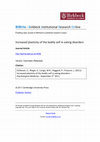
Psychological medicine, 2012
Background The rubber hand illusion (RHI) has been widely used to investigate the bodily self in ... more Background The rubber hand illusion (RHI) has been widely used to investigate the bodily self in healthy individuals. The aim of the present study was to extend the use of the RHI to examine the bodily self in eating disorders (EDs).Method The RHI and self-report measures of ED psychopathology [the Eating Disorder Inventory – 3 (EDI-3) subscales of Drive for Thinness, Bulimia, Body Dissatisfaction, Interoceptive Deficits, and Emotional Dysregulation; the 21-item Depression, Anxiety and Stress Scale (DASS-21); and the Self-Objectification Questionnaire (SOQ)] were administered to 78 individuals with an ED and 61 healthy controls.Results Individuals with an ED experienced the RHI significantly more strongly than healthy controls on both perceptual (i.e. proprioceptive drift) and subjective (i.e. self-report questionnaire) measures. Furthermore, both the subjective experience of the RHI and associated proprioceptive biases were correlated with ED psychopathology. Approximately 23% of the variance for embodiment of the fake hand was accounted for by ED psychopathology, with interoceptive deficits and self-objectification significant predictors of embodiment.Conclusions These results indicate that the bodily self is more plastic in people with an ED. These findings may shed light on both aetiological and maintenance factors involved in EDs, particularly visual processing of the body, interoceptive deficits, and self-objectification.(Received April 11 2011)(Revised August 31 2011)(Accepted September 06 2011)(Online publication October 05 2011)

Neuroscience and biobehavioral reviews, 2013
Social and emotional problems have been implicated in the development and maintenance of eating d... more Social and emotional problems have been implicated in the development and maintenance of eating disorders (ED). This paper reviews the facets of social processing in ED according to the NIMH Research and Domain Criteria (NIMH RDoC) 'Systems for Social Processes' framework. Embase, Medline, PsycInfo and Web of Science were searched for peer-reviewed articles published by March 2013. One-hundred and fifty four studies measuring constructs of: attachment, social communication, perception and understanding of self and others, and social dominance in people with ED, were identified. Eleven meta-analyses were performed, they showed evidence that people with ED had attachment insecurity (d=1.31), perceived low parental care (d=.51), appraised high parental overprotection (d=0.29), impaired facial emotion recognition (d=.44) and facial communication (d=2.10), increased facial avoidance (d=.52), reduced agency (d=.39), negative self-evaluation (d=2.27), alexithymia (d=.66), poor understanding of mental states (d=1.07) and sensitivity to social dominance (d=1.08). There is less evidence for problems with production and reception of non-facial communication, animacy and action.

The International journal of eating disorders, 2013
ObjectiveIndividuals with an eating disorder experience the rubber hand illusion (RHI) significan... more ObjectiveIndividuals with an eating disorder experience the rubber hand illusion (RHI) significantly more strongly than healthy controls on both perceptual (proprioceptive drift) and subjective (self-report embodiment questionnaire) measures. This heightened sensitivity to visual information about the body, and/or reduced somatosensory information processing about the body, suggest an increased malleability of the bodily self. The aim of the present study was to explore whether this is a state phenomenon or a persisting individual trait that outlasts the period of acute eating disorder.Individuals with an eating disorder experience the rubber hand illusion (RHI) significantly more strongly than healthy controls on both perceptual (proprioceptive drift) and subjective (self-report embodiment questionnaire) measures. This heightened sensitivity to visual information about the body, and/or reduced somatosensory information processing about the body, suggest an increased malleability of the bodily self. The aim of the present study was to explore whether this is a state phenomenon or a persisting individual trait that outlasts the period of acute eating disorder.MethodThe RHI and self-report measures of eating disorder psychopathology (EDI-3 subscales of Drive for Thinness, Bulimia, Body Dissatisfaction, Interoceptive Deficits, and Emotional Dysregulation; DASS-21; and the Self-Objectification Questionnaire) were administered to 78 individuals with an eating disorder, 28 individuals recovered from an eating disorder, and 61 healthy controls.The RHI and self-report measures of eating disorder psychopathology (EDI-3 subscales of Drive for Thinness, Bulimia, Body Dissatisfaction, Interoceptive Deficits, and Emotional Dysregulation; DASS-21; and the Self-Objectification Questionnaire) were administered to 78 individuals with an eating disorder, 28 individuals recovered from an eating disorder, and 61 healthy controls.ResultsProprioceptive drift in recovered individuals was intermediate between the acutely ill and HC groups. Subjective report of the strength of the illusion in recovered individuals was similar to acutely ill individuals.Proprioceptive drift in recovered individuals was intermediate between the acutely ill and HC groups. Subjective report of the strength of the illusion in recovered individuals was similar to acutely ill individuals.DiscussionThese results suggest that increased malleability of the bodily self persists, at least partially, following recovery and may be a trait phenomenon in people with eating disorders. Those with a lifetime history of an eating disorder may have heightened sensitivity to visual information about the body and reduced somatosensory information processing of the body. © 2013 Wiley Periodicals, Inc. (Int J Eat Disord 2013)These results suggest that increased malleability of the bodily self persists, at least partially, following recovery and may be a trait phenomenon in people with eating disorders. Those with a lifetime history of an eating disorder may have heightened sensitivity to visual information about the body and reduced somatosensory information processing of the body. © 2013 Wiley Periodicals, Inc. (Int J Eat Disord 2013)
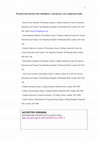
International urogynecology journal, 2014
Introduction and hypothesis Our goal was to determine psychosexual outcome after labiaplasty in t... more Introduction and hypothesis Our goal was to determine psychosexual outcome after labiaplasty in the long-term with specific measures of genital body image and sexual dysfunction. Method We conducted a prospective study with a matched-comparison group of women not wanting labiaplasty. Forty-nine women were compared against a group of 39 women matched for age, sexual orientation, ethnicity, and marital status. The labiaplasty group was assessed before, 3 months after and between 11 and 42 months after surgery. The comparison group was assessed at two time points 3 months apart to control for the passage of time. The primary outcome measure was the Genital Appearance Satisfaction (GAS) scale. Results Of the 49 women receiving labiaplasty, 19 (38.8 %) were lost to follow-up but were reassessed clinically. Twenty-four of 25 (96 %) women in the labiaplasty group showed a reliable and clinically significant improvement on the GAS scale 3 months after the procedure; 21/23 (91.3 %) showed an improvement at the long-term follow-up. A large effect size was found for improvements on the GAS scale in the labiaplasty group. Small-effect sizes were found for improvements in sexual functioning. Nine women obtaining labiaplasty met diagnostic criteria for body dysmorphic disorder before the operation; eight lost that diagnosis at the 3-month follow-up; 26 % reported minor side effects. Conclusions Labiaplasty is effective in improving genital appearance and sexual satisfaction, but larger studies are required to determine the prevalence of potential side effects.
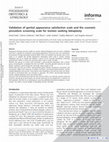
Journal of …, 2013
Background: Existing outcome studies on women seeking labiaplasty have not used a validated scale... more Background: Existing outcome studies on women seeking labiaplasty have not used a validated scale that is specific for satisfaction with genital appearance. They have also not screened for the presence of body dysmorphic disorder (BDD). There are therefore two primary aims of this study (1) to validate the Genital Appearance Satisfaction (GAS) scale in women seeking labiaplasty and (2) to modify and validate a version of the Cosmetic Procedures Screening questionnaire (COPS-L), which has previously been used to screen for BDD. Method: Two groups of women were recruited: a group desiring labiaplasty and a control group. All participants completed the GAS, the COPS-L and other general measures of mood, disgust sensitivity, sexual satisfaction and body image quality of life. Results: Both the GAS and COPS-L demonstrated good internal consistency, concurrent and convergent validity with measures of related constructs, and discriminated between women seeking labiaplasty and controls. Three factors were identified in the GAS but were not robust enough to recommend their use clinically as subscales. The COPS-L discriminated between women seeking labiaplasty with and without BDD. Discussion: We recommend that both the GAS and the COPS-L be routinely used for audit and outcome monitoring of interventions for women distressed by the appearance or function of their genitalia. The GAS has an advantage in assessing additional functional symptoms in such women. The COPS-L may be helpful in identifying women with BDD. J Psychosom Obstet Gynaecol Downloaded from informahealthcare.com by Ms Sarah Fay on 02/26/13 For personal use only. 48 D. Veale et al. J Psychosom Obstet Gynaecol, 2013; 34(1): 46-52 J Psychosom Obstet Gynaecol Downloaded from informahealthcare.com by Ms Sarah Fay on 02/26/13 For personal use only. Items in bold refer to the factors extracted which are 40.4. 50 D. Veale et al. Validation of genital appearance satisfaction scale and the cosmetic procedure 51 J Psychosom Obstet Gynaecol Downloaded from informahealthcare.com by Ms Sarah Fay on 02/26/13
Uploads
Papers by Ertimiss Eshkevari